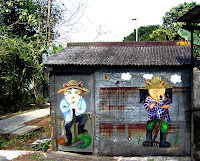Paula and I spent a lot of time during the holiday period trying to establish a cycle route to the wetland areas in the northwest of the New Territories, which I plan to write about in the next few days, and we also attended the fireworks display over Victoria Harbour on the second day of the new year. I missed last year’s display, mainly because I didn’t fancy standing around for two hours with a full-length plaster on my leg, but without such an encumbrance it was, as usual, well worth the wait. Also as usual, the organizers included several new effects, and while I’ve not seen the displays put on by other cities, they would have to be exceptional to surpass Hong Kong’s efforts, which involve firing more than a thousand shells a minute into the air for 22–23 minutes. The big mystery is why so many spectators faff about trying to shoot video of the display, an endeavour at which they may be successful, but only by sacrificing any immediate enjoyment of the spectacle.
For the first time, we had firecrackers to accompany the blessing of the roast pigs, which were then consumed immediately, as per tradition. I have to say that this type of roast pork is absolutely delicious, and I probably ate more than I should have done, but it is difficult to resist. The eleven-course village dinner was actually a lunch this year, mainly because some residents complained that it was too cold at night, although this winter has been exceptionally mild, and the main problem with a daytime meal is that there is no entertainment. I missed last year’s dinner too, for the same reason that I missed the fireworks, so it was good to get involved in the celebrations once again.
Here are a few photos from the ceremony to bless the roast pigs:
A makeshift altar has been set up to bless the roast pigs. Red, in case you hadn’t guessed it, is a lucky colour to the Chinese, which is why so-called ‘lucky money’ (lai see), a traditional gift at this time of year, is always placed in a red packet.
Don’t stand too close. This string of firecrackers is about to get considerably more violent.
I’m not really carving the pig, merely posing for the camera.









